5.2 Sanitation situation
In this section, different aspects of the sanitation situation in
Cap-Haitien are shown:
defecation practices are estimated using the survey, for
different areas. Technologies
are reviewed, regarding public and communal toilets, private
latrines, and the special case of overhung latrines over water. Pit emptying is
also considered.
5.2.1 Defecation practices
Past reports on defecation practices in Cap-Haitien are rare;
the only figures available come from a PHAST workshop done in 2005 in
flood-prone areas (including Petite- Anse and zones comparable to Shada),
reporting that 44.2% of the 500 respondents practised open defecation, 33.8%
used plastic bags, 19.4% went to the sea or river, and
2.6% used a latrine2. The survey gave some more
information as results could be related
to each area; they are shown in Table 5.2 below. Note that
the cumulative percentage can be higher than 10 %, as some respondents quoted
two methods: those using public latrines often use another form at night or for
their children, usually a bucket or plastic bag.
It presents a situation where open defecation is high, between 50
and 75% (see Figure
5.2 below); the low percentage in Bas-Ravine comes from the
more common use of plastic bags which are discarded in the ravine bed, and
buckets emptied the same way. Public latrines are claimed to be used in Shada
and Bas-Ravine. However, in both zones people admitted that «they do
not always go to the public latrine», and then use buckets or plastic
bags. The shared latrines in Mansui come from the USAID-financed programme
detailed in Section 5.2.4 on page 38. Overhung latrines on water are used only
in Shada, by 7 interviewees (21%).
|
Method
|
Shada
|
Petite-Anse
|
Mansui
|
Bas-Ravine
|
Total
|
|
Private latrine
|
3 %
|
16 %
|
10 %
|
33 %
|
15 %
|
|
Shared latrine
|
-
|
-
|
20 %
|
4 %
|
5 %
|
|
Public latrine
|
21 %
|
-
|
-
|
25 %
|
13 %
|
|
Neighbour's latrine
|
3 %
|
20 %
|
20 %
|
17 %
|
14 %
|
|
Overhung latrine
|
21 %
|
-
|
-
|
-
|
7 %
|
|
Bucket / potty
|
9 %
|
20 %
|
5 %
|
17 %
|
3 %
|
|
Plastic bag
|
9 %
|
4 %
|
-
|
21 %
|
9 %
|
|
Open defecation
|
74 %
|
72 %
|
55 %
|
25 %
|
58 %
|
Table 5.2: Defecation methods in each area
The level of satisfaction is detailed in Appendix H. Most
inhabitants are dissatisfied
with their current defecation practices, which is not much
surprising. In each area, the only persons who are either «happy» or
have an «average opinion» are those who own a latrine; the only
exceptions are a person in Bas-Ravine who «does not mind using plastic
bags», and another person in Shada who lives next to a recently built
public latrine. Conversely, some latrine owners were not satisfied with it,
particularly in Mansui, as detailed in Section 5.3.2.
5.2.2 Public toilets
There are about 15 public toilets in the city, built mostly
during the last five years. Seven
of them have been financed by FEKOKAP, and are managed by
local committees; three have been built by the city council in the city centre;
others have been built by local organisations. Most of those toilets are
unclean and / or are not heavily used. The only
2 Source: Report from the PHAST (Participatory Hygiene
And Sanitation Transformation) survey, where
500 people were asked confidentially about their defecation
method; carried out in early 2005 in the zones of Conasa, Fougerolles, Fort
Saint-Michel and Petite-Anse.
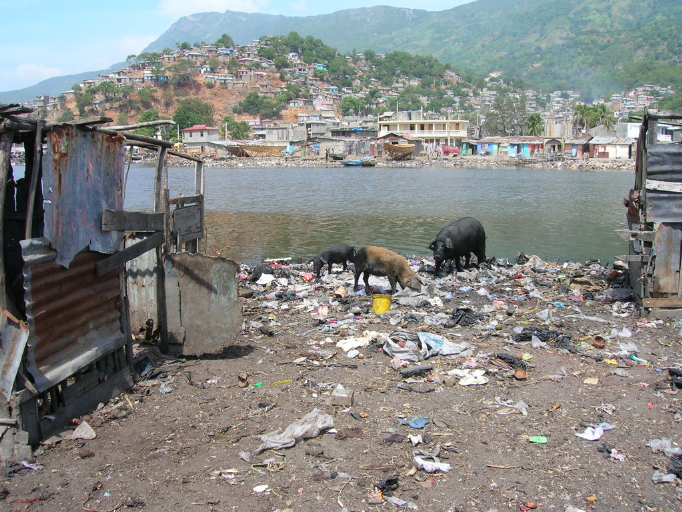
Figure 5.2: Open defecation area in Shada.
A woman from a women's organisation wanted to show this area
during the survey. It
is used for pigs and solid waste, and as a playground.
notable exceptions are the public toilet block next to the market
in the city centre, which
is heavily used by sellers (mostly by the women and children)
even if smelly and a bit expensive (3 Gourdes); and a public toilet built by a
local CBO in the area in Conasa, which is quite pleasant and well managed, but
seems to be restricted to close neighbours
as it attracts less than 50 people per day according to the
managers. Usual prices are 1
to 2 Gourdes, but 3 to 5 Gourdes in the city centre.
Many of these toilets seem to have been built for political
reasons, given their loca- tion: either in visible places (tourists' market,
harbour avenue) or in «politically active» areas, like Shada or
Bannann which are well-known for their very vindictive inhabitants. Management
seems to be poorly done: money does not seem to be collected and saved
efficiently, most toilets have broken parts (usually the door or the roof) and
have raw faeces visible on the seats during the visit; two of them have full
pits, yet the commit- tees invariably answer that «[they] do not have
money to perform repairs or empty the pits», and ask for assistance.
It can be reasonably said that, without the provision of an
emptying system and reli- able management systems, public toilets will only
have a limited impact on the sanita- tion situation and do not correspond to a
form of «sustainable sanitation».
5.2.3 Communal toilets
There are around 95 communal toilet blocks, found in the
Cités in planned mid-density urban areas, built in the 1980s to answer
the migration from rural areas. Each block has 6 to 8 chambers, sometimes
with a shower and / or a basin for laundry nearby
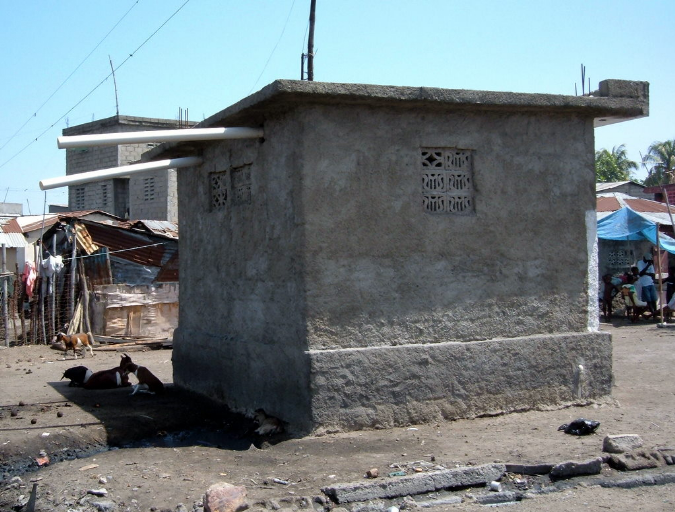
Figure 5.3: Public toilet in Shada.
The drainage ditch on the left goes directly in the river, a few
metres away.
(see Figure 5.4). Over time, the pits have filled up and the
superstructures have been degraded, to the point that most of those communal
toilets are now out of order. The
EPPLS (managing organisation) estimates the cost of emptying and
repair at more than
2 million Gourdes (US$ 52,600), however the EPPLS is heavily
indebted due to most tenants not paying their rent.
There is no clear management system for these toilets:
neighbours are supposed to take care of them, a system maybe sufficient for
daily cleaning but unable to cope with repairs and emptying. Even if repaired
and emptied, the toilets would not be sustainable
as the same problem is likely to happen after a few years.
When talking with residents, they say that the pits now fill up in about three
years only, due to residual solids in the bottom which cannot be emptied.
5.2.4 Private latrines building programmes
Three private latrine building programmes have been done in
Cap-Haitien in the last 15
years. In all these projects, materials were given to
beneficiaries and masons were paid
by the project; beneficiaries had to dig the pit, sometimes
transport the materials if they lived in remote areas, and possibly give a hand
during the building. There is no evidence
of any further participation of beneficiaries, especially
during the planning phase. It can also be noted that in all instances, the
projects were implemented in areas where the main members of organisations
lived.
The first and most important one has been run by the MSPP in 1990
with funding from
the German organisation Hydroplan. About 500 latrines were built
in three different areas of the city (Sainte-Philomène, Petite Anse and
Cité du Peuple). There were two
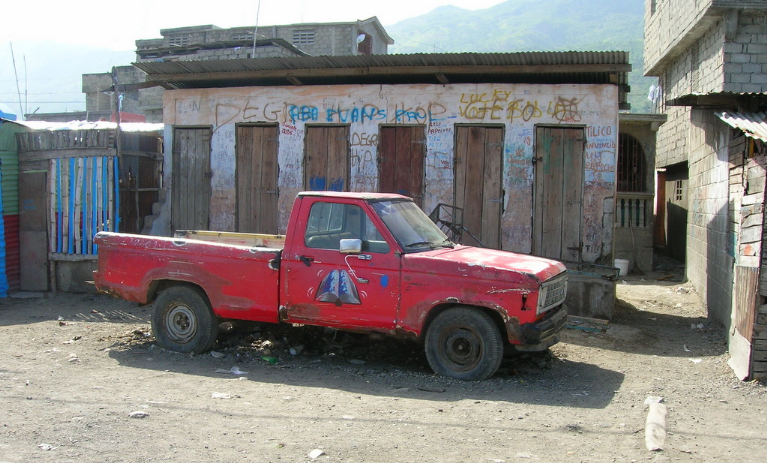
Figure 5.4: Communal toilets in Nan Bannann.
This block is one of the best maintained; maintenance of a few
toilet blocks in Nan
Bannann and La Fossette is done by a group of women called Fanm
Vayan.
different but still similar types of latrines, one for areas with
a high water table, the other
for areas on the hillside: both had a 1.5 to 2 m deep pit lined
with cement blocks, a 10
cm thick concrete slab with a pedestal, a 4» PVC ventilation
pipe and a superstructure
in cement blocks with galvanised iron roof. Each latrine used
to cost about US$ 30, but MSPP technicians estimate that it would now cost
about US$ 250 to build the same. Many of these latrines are now full or broken
down.
The partner organisation GTIH has built about 20 latrines in
2003, each for two fami- lies, in parallel with drainage and pathways
improvement projects. Materials have been given but almost no follow-up was
done, ending in latrines only partly built or used as showers.
The organisation AMPB (Association des Militants Progressistes de
Bel-Air) has built
40 latrines in 2004, with financial support from USAID, mostly
in the area of Mansui. Latrines are shared between houses and usual have two
chambers, and otherwise are similar to the latrines built by the MSPP (Figure
5.5 below). A more detailed evaluation
of this project can be found in Section 5.3.2.
No other recent latrine building programme could be
identified.
5.2.5 Self acquired private latrines
Types of latrines
Data on private owned latrines is scarce outside of the
projects mentioned above. Most results come directly from field visits and the
survey undertaken in this research; how- ever, the low coverage of private
latrines means that only a few results were obtained. Only 23 households
surveyed had a latrine; of them, 4 had obtained one from the US- AID programme;
another 7 respondents had an unfinished one, and a person had a full
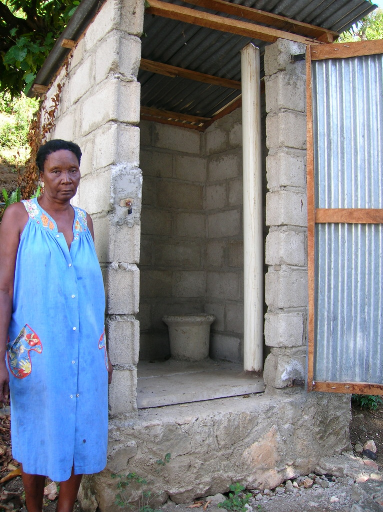
Figure 5.5: A latrine in Mansui, built by the USAID-financed
programe.
latrine pit so could not use it. This leaves only 11 households
(out of 103) with a fully constructed latrine in usage.
Results from the survey and from field visits tend to indicate
that only three types of latrines can be found: flush toilets,
«standard» latrines and «wooden» latrines (latrinn bwa).
Flush toilets were not found during the survey but can be seen in wealthier
areas and in the city centre, where space and revenue is available for septic
tanks. «Wooden» latrines represent the low-cost option, which is not
highly regarded, consisting of a shallow pit covered with wooden planks and a
basic superstructure. Surprisingly few of these latrines could be found, only
in the areas uphill.
The «standard» latrine corresponds to those
introduced by the MSPP in 1990: 2 - 3 m deep pit lined with cement blocks,
thick reinforced concrete slab, a seat, a ventilation pipe, a superstructure
with cement blocks and a corrugated iron sheet roof. All intervie- wees who had
started to build a latrine wanted this type, as it is supposed to be «more
hygienic», or because «if you build a latrine, you have to build one
like this!»
Latrine acquisition process
Some interviewees were in the process of building a latrine,
having either a dug pit or sometimes a slab already in place, and waiting until
they had enough money to carry
on building. The total time to build a latrine seems to spread
amongst several months, with two persons aiming to finish it after two years.
The reason is that latrines are
usually expensive (see also Table E.2) and that building is
incremental: the latrine is
built section after section, depending on money available.
The owner usually contacts a mason (called Boss maçon or
simply Boss), who gathers
a team of labourers if needed; it is often someone else who
digs the pit, either the owner or separate workers, who can be recommended by
the mason. If the mason is working on several constructions, he buys a
truckload of gravel and sand and uses it
for all constructions; however, for elements which have to be
bought one by one (such
as cement blocks or a ventilation pipe), this is usually the
owner's responsibility. The masons are paid either on a daily basis, or more
frequently for a given work; labourers
are paid a daily wage.
Reasons for having a latrine
Amongst the 23 latrine owners who were interviewed, 6 did not
know why the latrine was built as they moved in an already equipped house; 3
more had built their latrine
to replace an old one. For the remaining, the main reasons
for building a latrine were either to avoid going to the nature (5) or they
built it at the same time as their house or shortly after (5), saying that it
should be an integral part of their house. Another reason was «for the
visitors» (2).
Amongst those who do not own a latrine yet but who have the
intention to build one,
the main reason varied depending on the area: in Bas-Ravine,
the majority (5) said they wanted a latrine because «it is more practical
than going to the public latrine or using plastic bags»; in Shada, people
said that «we don't want to go at night, because then
we can be attacked», or «we don't want to go to the
sea anymore because we have to cross the main road, which is dangerous for
children». Example of recent assaults and accidents have been quoted in
Shada and in Mansui, though it is unknown whether it was to impress the
researcher (as suggested by his assistant) or about actual events.
Other motivations seem to be more marginal, and include, in
decreasing importance order, «for the visitors», «because it is
necessary» (without explaining further despite questions), «for the
house I am currently building», and «for health /
cleanliness».
Reasons for not having a latrine
The respondents without a latrine were asked for the main
constraints they face which prevent them from having one. The money constraint
was the main one in all areas, quoted by 53 % (Bas-Ravine) to 100 % (Mansui) of
respondents; it was sometimes precised, with interviewees saying that the
price of materials keep increasing (Shada)
or that there was too much unemployment (Petite Anse). The
space constraint was mentioned in Shada mainly (27 %). Other constraints
appear to be more marginal, and include «I have other priorities» (2
in Bas-Ravine, 1 in Shada), soil erosion (Bas-
Ravine), «I want a really good one, but I can't afford
it» (Mansui), «my wife does not
want us to have a latrine because it will smell bad»
(Shada), «I have too many children»
or «I am pregnant and I can't think of any future plan right
now» (Petite-Anse).
One person living in Mansui also said that werewolves (lougawou)
live in latrine pits, and it would be dangerous to go to the toilet at night,
which made him prefer a bucket.
5.2.6 Overhung latrines
Overhung latrines can be found near the river, which is
actually an estuary with sea water, and on the seafront. They are simply built
on wooden stilts and covered with locally available materials such as rice bags
or more often cloth. Faeces are dropped in
the water or on piles of solid waste underneath; see Figure
5.6.
While overhung latrines pose the same health and environmental
hazards as open defecation, they provide privacy and protection, particularly
for women. In many cases, they also provide revenue for their owner: in the
zone of Shada, most people who use overhung latrines have to pay 1 Gde each
time; one person said he pays 2 Gdes every time. However, 92 % of those who
practise open defecation go near the sea (the remain- der uses a terrain owned
by the Ministry of Transport and Public Works), most of them
on designated areas, and said they prefer the discomfort rather
than paying 1 Gourde every time.
Two interviewees also said they had the intention to build an
overhung latrine, in order to create revenue. One of them had already stolen
wood for this.
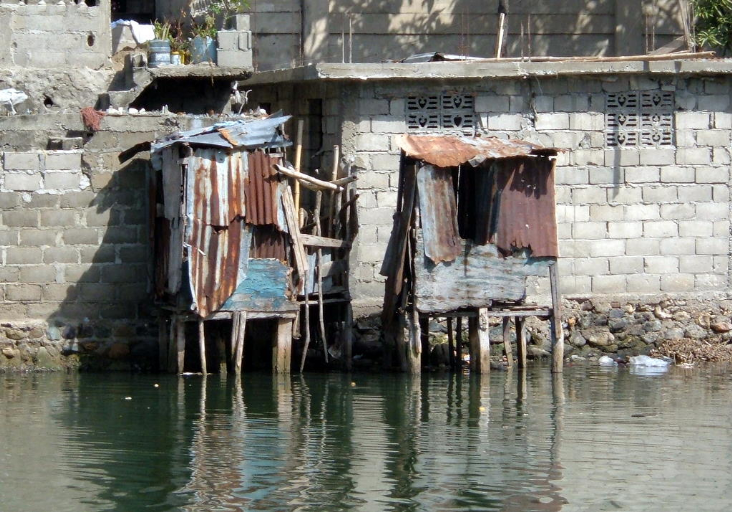
Figure 5.6: Overhung latrines in Northern Shada.
5.2.7 Pit emptying
Jedco
There are two ways of emptying latrine pits in Cap-Haitien: the
first is the private com- pany, Jedco, which operates two vacuum tanker trucks
of 2500 and 3000 gallons capac-
ity (10 - 12 m3). They work on contract only, and
most of the time for the UN forces
of the Minustah, whose bases have many septic tanks. The
emptying cost is around
10,000 Gdes (US$ 250) per truckload. The location of their
two dumping grounds is not precisely known, and the local manager was reluctant
to give that information. It is possible that the trucks dump their contents in
the mangrove in uninhabited areas.
Bayakous
The other way to empty a latrine pit it to ask a
«bayakou», the usual name for people whose job is to empty pits. The
bayakous interviewed said they work at night, usually in teams of 3 to 5, using
shovels and buckets, with limited protection gear. The emptying cost varies
depending on the source: the MSPP director quotes an average of 5,000 Gdes (US$
120) for a private latrine with a medium pit, interviewees in the survey quoted
prices from US$ 60 to US$ 150, and the bayakous interviewed said that emptying
a communal latrine with a larger pit costs 20,000 Gdes (US$ 520). This is a
significantly higher price per load than from Jedco, yet the size of their
trucks and their contract- based work prevents them from operating in poorer
and denser areas. The bayakous often have to break the slab, which adds the
repairing cost for the user.
The bayakous suffer from poor working conditions, which is in
part the justification
for their high rate of pay: they use créolène, a
liquid disinfectant, to attenuate the smell, but they are still forced to enter
the pits to empty them; finding solid waste is not unusual
in the pits, and Public Health workers have reported bayakous
treading on hazardous medical waste and being infected. They also suffer from
an «illegal» status after some
of them had dumped a pit contents in the sea, close to the
city centre: offenders have been imprisoned and the city council claims to be
willing to find a suitable dumping site, however the bayakous doubt that a
solution will be found.
Usually, the pit content is transferred to another pit dug right
next to it. The bayakous
interviewed claimed to transport it on about 2 km when a pit
cannot be dug, e.g. when
the water table is too close. There have been reports of a pit
contents dumped in front
of a bank in the city centre, and another case of faeces bought
from bayakous in order
to «paint» a house, for political reasons.
Other
The MSPP used to have a emptying machine, consisting of a
self-propelled 2.5 m3 vacuum tanker with a 1.4 m3
trailer tank, donated by a German cooperation in 1990 (see the trailer on
Figure 5.9, page 53). It was in operation for 5 years, after which it broke
down and could not be repaired given the lack of spare parts; the machine
and
the trailer are now rotting in the MSPP yard. The MSPP
subsequently used bayakous
to perform the emptying with a truck to transport the pit
contents in drums. The truck broke down as well in 2000, however, and the MSPP
lacked funds to hire bayakous anymore and stopped emptying pits.
| 


